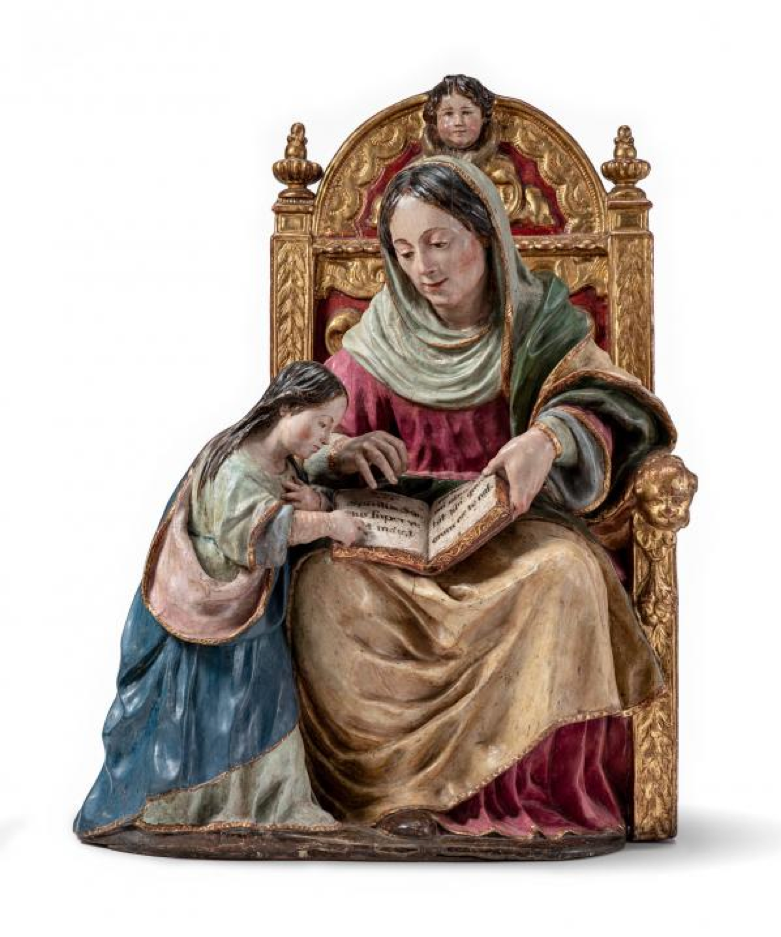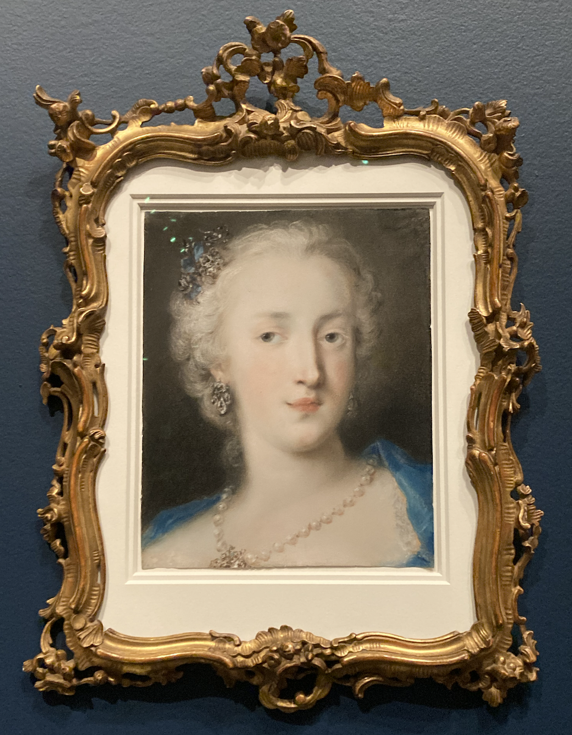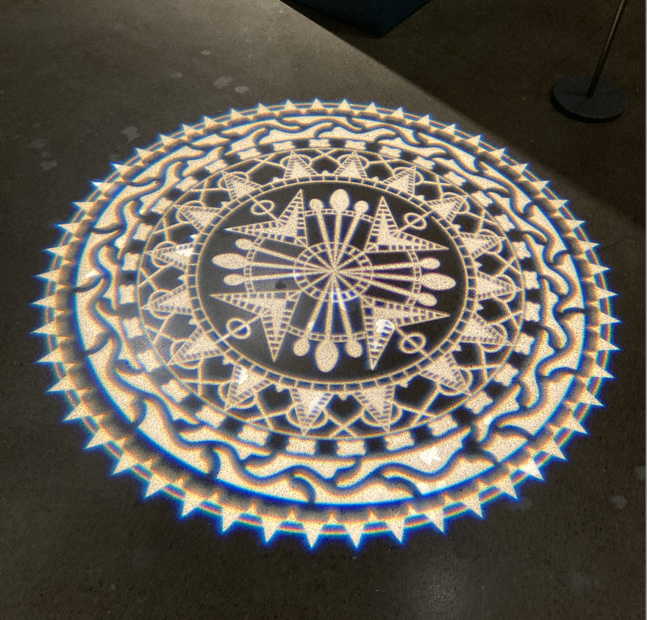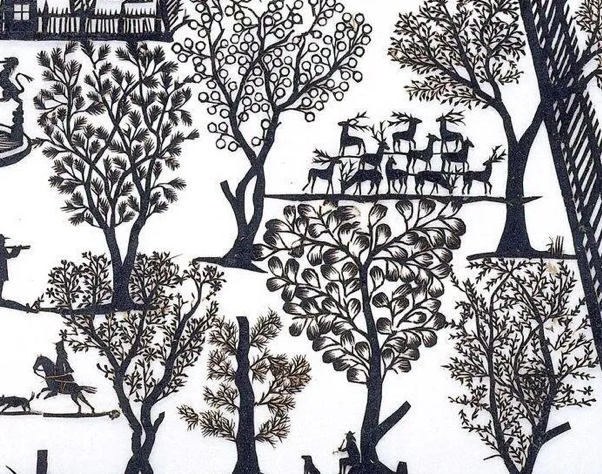Guest post by Isabelle Hawkins, Honors student in art history, McGill University

One of the many intriguing pieces on display at Making Her Mark: A History of Women Artists in Europe, 1400–1800 is the sculpture pictured above, of Saint Anne teaching the Virgin Mary to read, watched over by a cherubic face. On view at the Art Gallery of Ontario (AGO) until July 1, 2024, the exhibition is co-curated by Dr. Alexa Greist and Dr. Andaleeb Banta, and co-organized by the AGO and the Baltimore Museum of Art (BMA). Featuring over 230 pieces by European women makers across four centuries, the exhibition is expansive and thorough.

Making Her Mark opens with Linda Nochlin’s foundational question for feminist Art History: “Why have there been no great women artists?” To remedy this curatorial and scholarly void, Making Her Mark asks us to look outside the male dominated canon, the primacy of individual genius, and the hierarchy of mediums to appreciate the contributions of celebrated women and unsung makers.

A Medley of Mediums
Until recently, Western Art History has condescended to “craft” mediums. These forms of expression are often domestic, utilitarian, and dominated by women. Making Her Mark challenges the hierarchy of mediums with a thematic approach: different forms, equally important, sit side-by-side. The exhibition also includes an incredible quantity of mediums: painting, sculpture, print, book arts and illumination, ceramics, enamel, silver, furniture, quilling, weaving, tapestry, embroidery, hairwork, lace, drawings, pastels, watercolors, and scientific and natural illustration.

Even when women practiced painting, long considered art’s noblest form, they were barred from guilds, encouraged to paint only in their youth, and thought to lack the necessary talent to make good art. To stress the seriousness of women painters on display, the exhibition considers the artists’ innovative techniques, impact, and pieces formerly credited to celebrated male artists. Judith Leyster offers one example of such misattribution: for centuries after her death, her paintings were attributed to Frans Hals or to her husband, Jan Miense Molenaer. Object labels also highlight revealing information in the artists’ biographies that may have furthered or limited their creative production.

A Multi-Sensorial Experience
As art is a visual medium, sight is often the only sense we use to understand it. By appealing to vision, hearing, touch, and smell, Making Her Mark invites visitors to engage with objects in original ways. The variety of items in this exhibition—in terms of construction, size, and texture—is such that the eyes are never bored. Most rooms of the exhibition also display lace-like motifs projected on the floor.

In the exhibition’s first room, music composed by women in the 1600s and 1700s and recorded by the Tafelmusik Baroque Orchestra plays aloud. There are four touch stations throughout the exhibition. Though the BMA also invited viewers to touch certain materials, the AGO’s stations are different. Here visitors may run their fingers over samples of lace, quilling, hair, and beaded embroidery. The AGO has also included four scent stations, created in collaboration with Dr. Melanie McBride, founder of the Aroma Inquiry Lab:
- the first transports visitors to the cloister with incense and damp stones;
- the second combines floral parfum with body odor;
- the third evokes a snuff box with spiced tobacco; and
- the last replicates a garden with flowers, herbs, and soil.
Making Her Mark neglects only one sense: taste. Given that AGO does not allow food and drink in the galleries, including taste might be an unreasonable request.

The Exceptional and the Ordinary
Even now, histories and museum walls are unlikely to mention women artists unless they qualify as “exceptional.” While the male artist-genius is the most revered figure, exceptionalism is not so rigid a qualification for men. Making Her Mark honors women recognized as exceptional, including paintings from Sofonisba Anguissola, Artemisia Gentileschi, Judith Leyster, and Rachel Ruysch. The exhibition also honors exceptional pieces from less well-known makers, such as Sophia Jane Maria Bonnell and Mary Anne Harvey Bonnell’s paper filigree cabinet with hairwork panels. This piece stands out because of its unusual medium, extraordinary detail, and quality of preservation. As a piece of furniture decorated with thousands of pieces of tightly rolled paper, it is extremely fragile and subject to the wear and tear of daily use.

Giulia Lama’s Sketch of a man seen from behind, which appears only in the AGO version of the show, is exceptional not only for its beauty and accuracy, but for its subject matter. Mastery of the human body was understood as the foundation to artistic achievement. Women, however, often did not have access to live male nude models. While such opportunities for life drawing were not impossible, the onus was on the women who participated to create and negotiate them.

Making Her Mark attends equally to art from unknown artists. Of all the lace exhibited, only one lace engraving has a known maker. Including such a large amount of anonymous work challenges the art historical trope of the known male artist–genius. With pieces of lace, embroidery, and weaving it is less likely that we can identify the authors by name, and it is more likely that women executed them. In order to recognize women’s contributions, it is essential to exhibit items by authors whose names we don’t know.

Why You Should See this Exhibition
- Galleries do not often feature mediums like book illumination and typesetting. This is a rare opportunity to appreciate practices that museum shows often ignored.
- Exhibitions that engage multiple senses are rare. The invitation to touch lace, quilling, hair, and beaded embroidery violates the museum’s most prominent taboo: do not touch.
- With an incredible quantity of makers, Making Her Mark can introduce you to artists you had never heard of or pieces you do not recognize by artists you know.
- The exhibition is enormous and addresses fifteen themes ranging from art in the cloister, to the art of science, to entrepreneurial women. There is something for everyone.
- Making Her Mark prompts you to reconsider what qualifies as art, and who these distinctions hurt and privilege.

Isabelle Hawkins is a fourth-year undergraduate student pursuing an Honors BA in Art History at McGill University.
Making Her Mark: A History of Women Artists in Europe, 1400–1800 runs at the Art Gallery of Ontario through July 1, 2024.
More Art Herstory exhibition news:
Dutch and Flemish Women Artists—A Major Exhibition at the National Museum of Women in the Arts, by Erika Gaffney
Rachel Ruysch at Munich’s Alte Pinakothek, by Erika Gaffney
Roma Pittrice: Women Artists at Work in Rome Between the Sixteenth and Nineteenth Centuries, by Alessandra Masu
Museum Exhibitions about Historic Women Artists: 2024
Women Artists at the Cape Ann Museum, by Erika Gaffney
Making Her Mark, An Essential Corrective in the History of Art, by Chadd Scott
Reflections on Making Her Mark at the Baltimore Museum of Art, by Erika Gaffney
Carlotta Gargalli 1788–1840: “The Elisabetta Sirani of the Day,” by Alessandra Masu
Masters and Sisters in Arts, by Jitske Jasperse
Marie Laurencin: Sapphic Paris, A Review, by Alice M. Rudy Price
Material Re-Enchantments: A Review of Remedios Varo: Science Fictions, by Suzanne Karr Schmidt
Sofonisba Anguissola in Holland, an Exhibition Review, by Erika Gaffney with Cara Verona Viglucci
Rosa Bonheur—Practice Makes Perfect, by Ien G.M. van der Pol
The Ladies of Art are in Milan, by Cecilia Gamberini
In defense of monographic exhibitions of female artists: The case of Fede Galizia, by Camille Nouhant
“La grandezza del universo” nell’arte di Giovanna Garzoni / “The grandeur of the universe” in the art of Giovanna Garzoni, by Dr. Sara Matthews-Grieco




I will definitely go to see this exhibit after reading this well thought out review. Thank you for illuminating me.
Way to go Isabel! Amazing and interesting .Do you know Sophie Hacket?